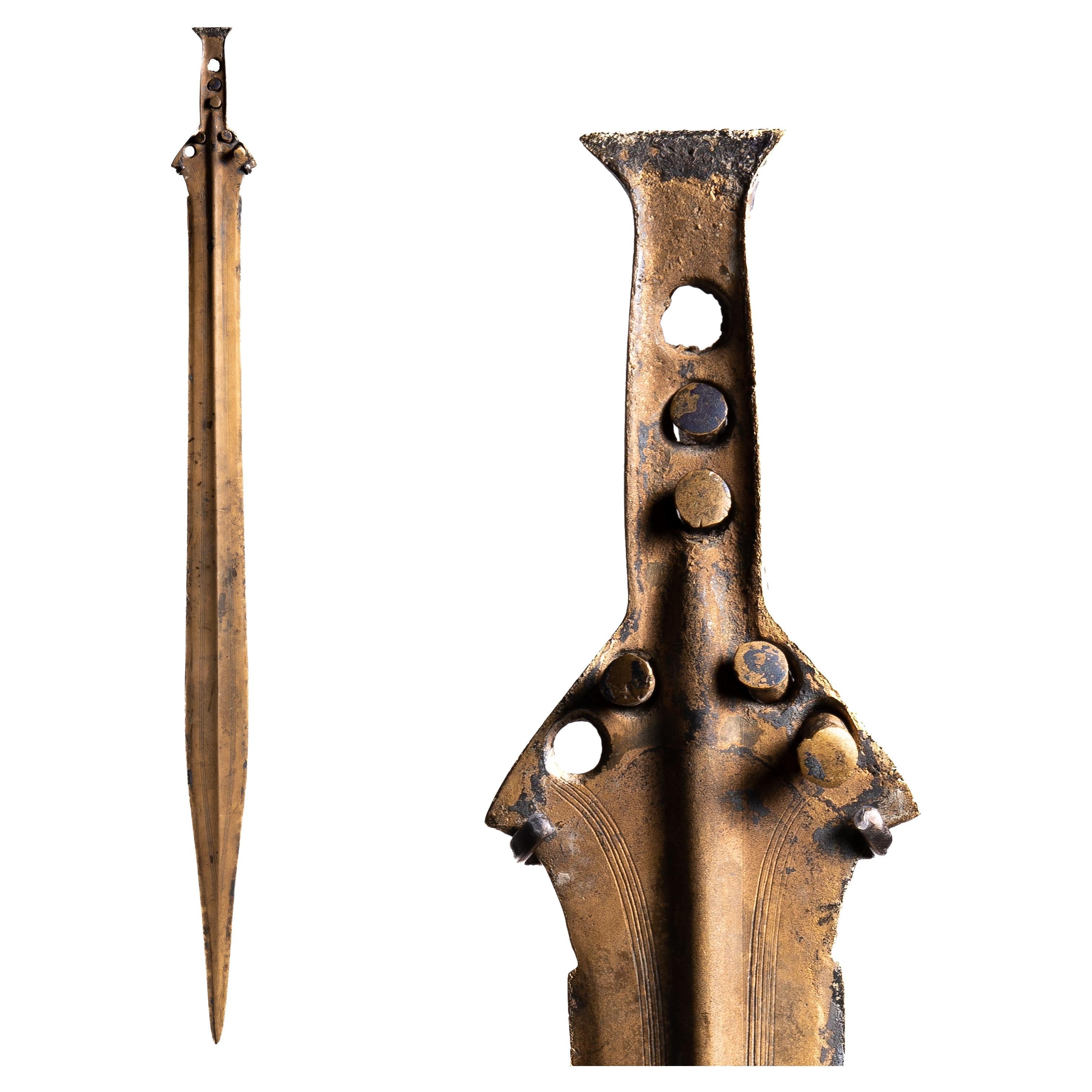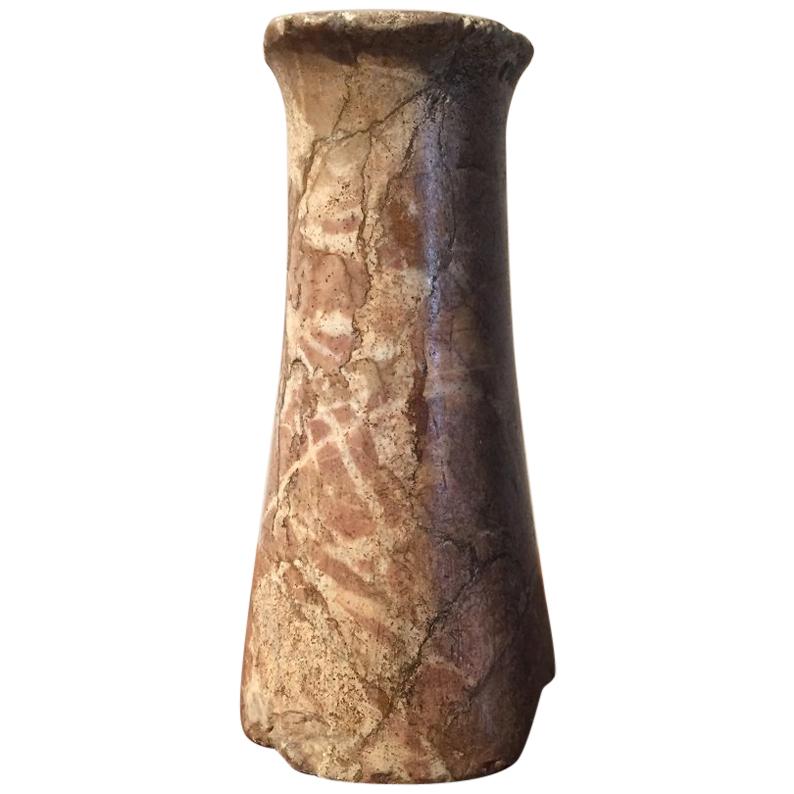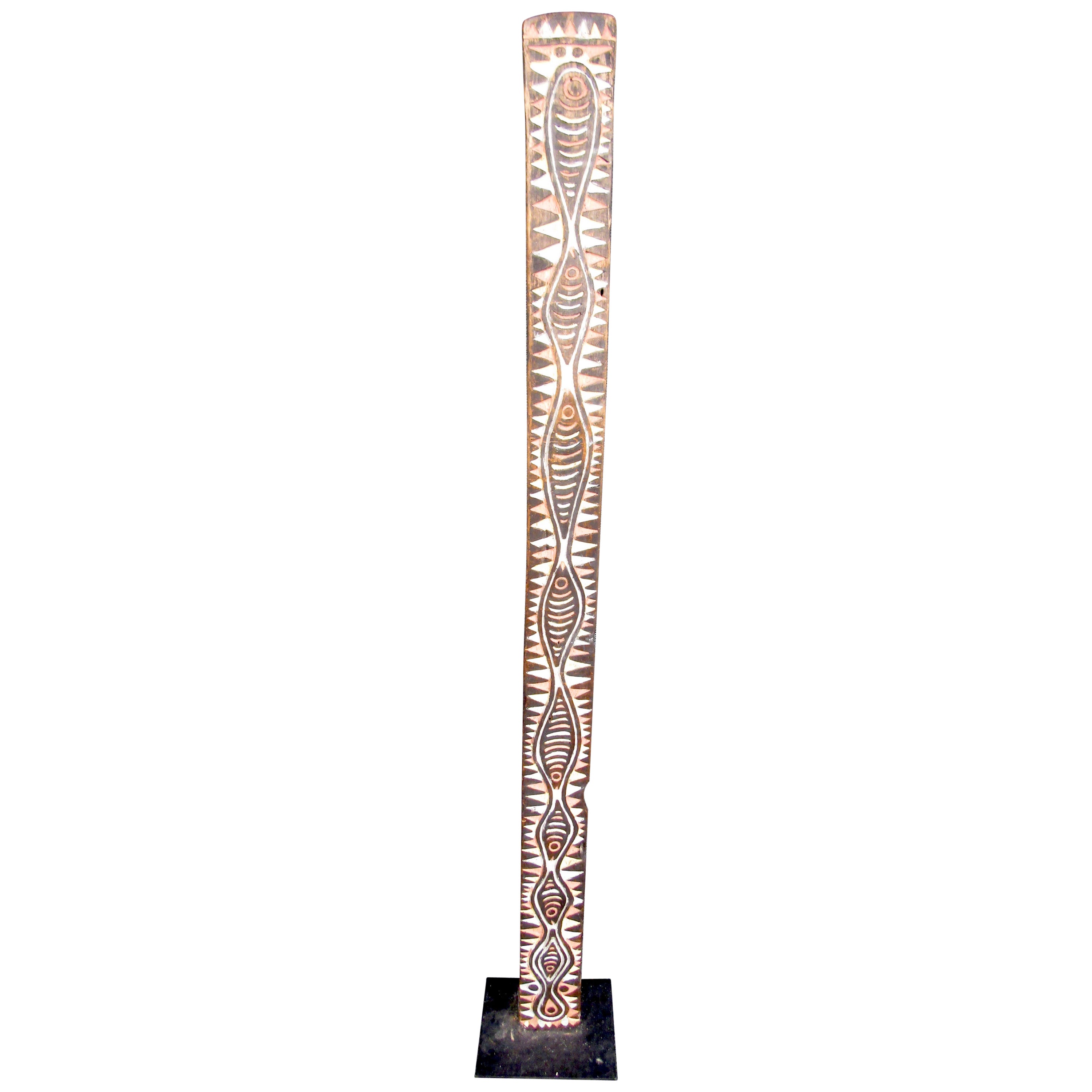Items Similar to Bronze Age Cypriot Plank Idol
Want more images or videos?
Request additional images or videos from the seller
1 of 7
Bronze Age Cypriot Plank Idol
About the Item
Cypriot Plank Idol
Early Bronze Age III - Middle Bronze Age I, c. 2100 - 1850 BC.
Low fired burnished earthenware pottery with lime-filled incisions
A Cypriot plank idol, an iconic form of human representation from Bronze Age Cyprus.
A highly stylised figurine, with a flat rectangular body and narrower head and neck, featuring incised lime-filled decoration across the top half of the body, and two incised lines dropping down from the shoulders. The nose depicted in relief, with incised eyes, eye- brows, nostrils and mouth. Waved line incisions on the edge of the head perhaps indicating hair.
Identified today with the elusive kingdom of Alashiya, Bronze Age Cyprus was an island of unique and distinctive culture. At the beginning of this period (c.2500 BC), migrants from Anatolia introduced the Philia Culture to the northern coast of Cyprus, establishing a new era in the island’s prehistory. Marking the end of the Chalcolithic period, innovative types of pottery were produced, and inhabitants began to experiment with new technologies of bronze metal production.1 In particular, the exploitation of copper resources in the Troodos foothills provided the foundation for acquiring and displaying wealth.2 In high demand throughout the Mediterranean world, Cypriots now exported large quantities of this raw material in exchange for luxury goods such as silver and gold, ivory, perfumed oils, and precious furniture.3 Through such trade, Cyprus established connections with Minoan Crete and Mycenaean Greece, as well as the ancient civilisations of Egypt and the Near East.4 Imported goods from these kingdoms were, in turn, used as status symbols. Over this period, the number and siz- es of settlements also increased, suggesting that this prosperity was underpinned by a rise in population.
The middle Bronze Age also marked an expansion in artistic production, typified by the proliferation of new types of pottery, including Black Slip ware, Red-on-Black ware and white painted ware. Moreover, potters now produced large ‘scenic vessels’ which depicted the everyday activities of the island’s inhabitants, providing invaluable evidence to archaeologists and anthropologists today. The cultural affluence of this period also resulted in huge quantities of grave-goods to accompany a person to the afterlife. The deposition of metal goods in particular reached remarkable heights during this period, and for the first time, tombs included items such as tools and weapons, as well as new types of pottery, and imported jewellery such as gold rings, diadems and faience necklaces. Such evidence has been particularly well documented during the three major excavations at Lapithos. Plank idols are also a common feature of these richly ornamented graves. Tombs themselves were now used for several generations, suggesting that greater emphasis was beginning to be placed on group or family identity. Indeed, this was a time of significant political and economic change, and the emergence of new social structures resulted in lavishly decorated tombs, fulfilling the emerging desire to visually confirm one’s social status, both in life and in death.
Forms of human representation by the artists of ancient Cyprus are easily identifiable to the period they come from. For the early and middle Bronze Age, the traditional form of human representation was the plank idol or figurine. These often simplified forms are highly stylised, with a flat rectangular body, and narrowed head and neck. Facial features and ornaments are indicated by incised and painted patterns, with the exception of the nose and ears (and occasionally breasts) which are modelled in relief. In some cases, they also have two heads, or three necks, or they even depict a mother holding a child. As highly expressive objects, with a significant aesthetic quality, it is clear they were made by skilled potters and designed for visual impact and display. Generally found in graves, their archeological context has led to the belief in their religious and symbolic significance.
When Cypriot plank idols were first discovered in 1913, they were tentatively identified as female. This was the result of their elaborate incised decoration and jewellery, as well as the discovery of some depicted with breasts modelled in relief. Just as large vessels from this period depict scenes from everyday life, it was thought that these figurines may have depicted women in their various roles, for example, as mothers or officiating at the sanctuary in full ceremonial dress. However, the significant absence of male figurines in a presumably patriarchal society led scholars to identify them with the fertility cult of the ‘Great Mother Goddess’. It has been noted that per- haps those idols with two heads or three necks may have been significant in asking for twins, triplets or a larger family. Given that these female figurines are frequently found in graves, it has also been suggested that the fertility goddess was a symbol of rebirth or regeneration.
However, more recently, the identification of plank idols with the Great Mother Goddess has been questioned, on account of the considerable number of figurines that bear no identifying features of the female sex. Instead, their appearance at a time of significant political, hierarchical and economic change, as well as their archaeological contexts has led to the belief that that plank ‘idols’ were in fact figurines designed as a conspicuous symbol of social prestige, and a marker of group identity with particular reference to ancestral authority.
Whether idol or ancestor, these figurines emerge from a crucial time in Cypriot early history, and their aesthetic nature means that they have been highly sought after by the modern collector.
Provenance:
Collection de Mme S.; Objets de Haute Curiosité et d’Archéologie, Hôtel Drouot, Paris, 2nd June 1967, Lot 99.
Mr and Mrs Jacques and Françoise Martinet collection, acquired at the above sale Thence by descent.
- Dimensions:Height: 9 in (22.86 cm)Width: 3 in (7.62 cm)Depth: 0.25 in (6.35 mm)
- Materials and Techniques:
- Place of Origin:
- Period:
- Date of Manufacture:Bronze Age, circa 2100 - 1850 BC
- Condition:Repaired. Wear consistent with age and use.
- Seller Location:London, GB
- Reference Number:1stDibs: LU1052238096252
About the Seller
5.0
Recognized Seller
These prestigious sellers are industry leaders and represent the highest echelon for item quality and design.
Established in 2008
1stDibs seller since 2014
100 sales on 1stDibs
Typical response time: 7 hours
Associations
LAPADA - The Association of Arts & Antiques DealersInternational Confederation of Art and Antique Dealers' AssociationsThe British Antique Dealers' Association
- ShippingRetrieving quote...Ships From: London, United Kingdom
- Return PolicyA return for this item may be initiated within 14 days of delivery.
More From This SellerView All
- Late Bronze Age SwordLocated in London, GBSaint Nazaire Sword, Late Bronze Age, circa 800-900 B.C. An exceptionally well preserved Bronze Age sword, with elegant, finely incised decorations,...Category
Antique 15th Century and Earlier French Abstract Sculptures
MaterialsBronze
- Etruscan Bronze Statuette of Discus ThrowerLocated in London, GBA remarkably fine example of Archaic sculpture. A figure of a discophoros, or discus bearer, standing with his right leg forward, gripping a discus in his right hand, the left arm raised with an open palm. Described with admiration in Münzen und Medaillen's 1961 auction, "The figure is a masterpiece and illustrates with rare vividness the essence of good Etruscan sculpture...Category
Antique 15th Century and Earlier Figurative Sculptures
MaterialsBronze
- Ancient Greek Hellenistic Bronze Statuette of SatyrLocated in London, GBBeautifully cast statuette of a satyr, Greek, Hellenistic Period, 3rd-2nd Century BC, solid cast bronze The present work is a wonderful example of the finest Hellenistic style. The ...Category
Antique 15th Century and Earlier Greek Classical Greek Figurative Sculpt...
MaterialsBronze
- Natural Gogotte FormationLocated in London, GB'Louis XIV' Gogotte Formation Measures: circa 30 Million y/o 105 x 76 x 15 cm A magnificent example of a gogotte formation, nicknamed Louis XIV, composed of thick swirls and folds of sparkling sandstone. Discovered in the Oligocene sand dunes of Fontainebleau, France, formed circa 30 million years before present or later. The incredible, almost otherworldly appearance of gogottes may easily be mistaken for the work of a most talented artist. In fact, these sandstone sculptures are entirely natural in origin. They have been found in multiple locations but those from Fontainebleau, such as the present example, are the most remarkable. Thirty-five million years ago, a sea covered what is now the forest of Fontainebleau, and dunes of exceptionally fine and homogenous sand formed. As silica-rich water filtered through this sand, it turned into stone. The flow of water finely modelled the sandstone into the forms we now know as gogottes. These are rare and are only found sporadically, several metres buried underground. They owe their sparkling white appearance to the extreme and unmatched purity of the Fontainebleau sand, sometimes reaching a composition of 99.9% silica. Each of them is unique – a masterpiece slowly fashioned by the hands of Nature. The name “gogotte” was coined by French geologist Claude Guillemin (1923- 1994), inspired by the children’s book series Babar the Elephant...Category
Antique 15th Century and Earlier French Natural Specimens
MaterialsSandstone
- Fossilised Colla Wood Cross-SectionLocated in London, GBFossilised colla wood cross-section Miocene, circa 5-23 Million y/o This fossilised white pine wood section displays a beautiful surface, with vibrant h...Category
Antique 15th Century and Earlier Turkish Natural Specimens
MaterialsStone
- Natural Gogotte FormationLocated in London, GBA magnificent example of a gogotte formation composed of thick swirls and folds of sparkling sandstone. Discovered in the Oligocene sand dunes of Fontainebleau, France, formed circa 30 million years before present or later. The incredible, almost otherworldly appearance of gogottes may easily be mistaken for the work of a most talented artist. In fact, these sandstone sculptures are entirely natural in origin. They have been found in multiple locations but those from Fontainebleau, such as the present example, are the most remarkable. Thirty-five million years ago, a sea covered what is now the forest of Fontainebleau, and dunes of exceptionally fine and homogenous sand formed. As silica-rich water filtered through this sand, it turned into stone. The flow of water finely modelled the sandstone into the aesthetic concretions we now know as gogottes. These are rare and are only found sporadically several metres deep into the ground. They owe their sparkling white appearance to the extreme and unmatched purity of the Fontainebleau sand, sometimes reaching a composition of 99.9% silica. Each of them is unique – a masterpiece slowly fashioned by the hands of Nature. The intriguing name of “gogotte” was coined by French geologist Claude Guillemin (1923- 1994), who was inspired by the children’s book series Babar the Elephant. In one of the books, a group of monsters called Gogottes are shown hiding behind rocks. These rocks reminded Guillemin of the sandstone concretions...Category
Antique 15th Century and Earlier Natural Specimens
MaterialsOther
You May Also Like
- Aged Bronze Bucking BroncosLocated in New York, NYPair of mid century Bucking Bronco horse figures with articulating back leg.Category
Mid-20th Century American American Classical Animal Sculptures
MaterialsBronze
- Bactrian Marble Column IdolLocated in Vosselaar, BEBactrian marble column idol, circa 3000-2000 Bc. It has a elegant tapering form with a undeep groove running on the top and bottom. The marble is a breccia type with striking vains i...Category
Antique 15th Century and Earlier Afghan Archaistic Antiquities
MaterialsMarble
- Aged Bronze Bull Bookends, B. SeibelBy Ben SeibelLocated in New York, NYPair of mid century bronze stylized bull bookends by Ben Seibel for Jenfredware.Category
20th Century American Mid-Century Modern Animal Sculptures
MaterialsBronze
- Tribal Plank ArtLocated in Brooklyn, NYUnique tribal plank art with metal base. The piece features a 5.5' tall wooden plank with a colored ornate fish design. Great conversation piece for any space.Category
20th Century Unknown Tribal Tribal Art
MaterialsMetal
- Archaic Jade Bi, Early Bronze AgeLocated in Atlanta, GATranslucent green and brown jade Bi from the early Bronze age. (2200 - 1900 B.C). The organic shapes created by the blending of these two main colors evo...Category
Antique 15th Century and Earlier Chinese Antiquities
MaterialsJade
- Large Bactrian Bronze Age Alabaster ChaliceLocated in Vosselaar, BEBactrian alabaster chalice, circa 3000-2000 BC. It has an elegant tapering formed base with a undeep rimmed cup. The alabaster is strikingly vained. ...Category
Antique 15th Century and Earlier Afghan Archaistic Antiquities
MaterialsAlabaster
Recently Viewed
View AllMore Ways To Browse
Grave Marker
Drop Ear Rings
David Hymes
Futurist Sculpture In Gilt Metal
Vasa Lucite Sculpture
Antonio Kieff Bronze Sculpture
Pbw Rock Crystal Sconces
Plantation Style Writing Desk
Rosewood Twin Beds
Royal Company Archers Badges
Set Eames Executive Office Chair Lobby Chair
Shield Back Baker Charleston
Solid Granite Black Iron Table
Space Copenhagen Swoon Dining Chair
Spanish Hunter Chair
Tao Kuang
Tavolo Artona
Thonet Bentwood Cantilever





